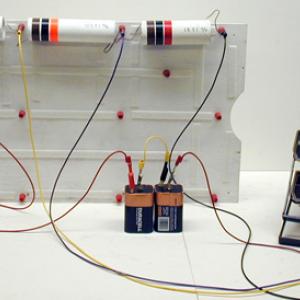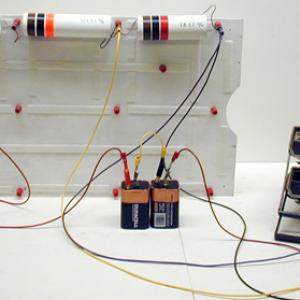College of Liberal Arts & Sciences
5F20.10 - Kirchhoff's Law
Video Credit: Jonathan M. Sullivan-Wood
Hook the resistors into parallel and series pairs. Attach a multimeter to each type circuit for measuring of voltages, capacitance, or resistances. Voltage drops across resistors may be demonstrated with this equipment.
Craig Kletzing has specific circuits he wants set up using 10 K resistors when demonstrating Kirchhoff's Law in class. Those circuit diagrams are in the 5F10.10 - Ohm's Law box along with all the multimeters needed.
John Prineas has several circuits he wants to show in class using lights in either a series circuit of three bulbs, or a parallel circuit of two bulbs to dispel the misconception that current gets "used up" in a circuit. Each circuit is set up with amp meters to show the input current, the current coming out of each bulb, and the output current. If desired you can also throw in a multimeter to measure voltages across the bulbs in the circuit.
John Prineas has a Kirchhoff's law circuit that has a 3K, a 6K, a 12K, and an 18K Ohm resistor. The circuit test ground lead and the common lead from the voltmeter are also grounded to the table power strip so that it is not floating. The ground test lead and the voltage lead from the voltmeter are then used to measure voltages anywhere around the circuit.
- Philip Keller, "A Quicker Way to Solve Series-Parallel Circuits", TPT, Vol. 57, #4, Apr. 2019, p. 260.
- C. E. Davis, J. L. Piffer, M. D. Cohen, and J. P. Polley, "Applying Thévenin’s Theorem and Kirchhoff’s Junction Rule to a Common RC Circuit", TPT, Vol. 57, #4, Apr. 2019, p. 242.
- James Lincoln, "Visual Electricity Demonstrator", TPT, Vol. 55, #6, Sept. 2017, p.374.
- Paul Hewitt, "Answer to February 2017 Figuring Physics", TPT, Vol. 55, #3, Mar. 2017, p. 179.
- Tom Bensky and William Bensky, "Community Outreach with Play-Doh® Electronics", TPT, Vol. 54, #8, Nov. 2016, p. 455.
- Ronald Brown, "Series and Parallel Resistors and Capacitors", TPT, Vol. 41, #8, Nov. 2003, p. 483.
- Kavork Spartalian, "Rectangles in Physics", TPT, Vol. 41, #7, Oct. 2003, p. 390.
- Thomas B. Greenslade Jr., "Additional References", TPT, Vol. 41, #7, Oct. 2003, p. 380.
- Dean Livelybrooks, "Feel" the Difference Between Series and Parallel Circuits", TPT, p. 102, Vol. 41, #2, Feb. 2003.
- Art Hovey, "Nomographs", TPT, Vol. 41, #1, Jan. 2003, p. 4.
- Thomas B. Greenslade Jr., "A Nomograph for Resistors in Parallel", TPT, Vol. 40, #8, Nov 2002, p. 458.
- Bernard Scott, "An Intriguing Problem in Equivalent Resistance", TPT, Vol. 26, #9, Dec. 1988, p. 578.
- P. P. Ong, "A Short-Circuit Method for Networks", TPT, Vol. 21, #7, Oct. 1983, p. 459.
- C. H. Wörner, "Simple Application of the Symmetry and Superposition Principles", TPT, Vol. 20, #7, Oct. 1982, p. 477.
- Robert P. Lanni, "The Loop Rule: Kirchhoff's or Aristotle's?", TPT, Vol. 19, #6, Sept. 1981, p. 256.
- Robert E. Viens, "A Kirchhoff's Rules Puzzler", TPT, Vol. 19, #1, Jan. 1981, p. 45.
- B. W. Ellis and C. A. Eckroth, "The Superposition Principle and Thevenin's Theorem Using the Kirchhoff's Laws Apparatus", TPT, Vol. 13, #8, Nov. 1975, p. 496.
- G. B. Hebert, "Spelling Lesson", TPT, Vol. 13, #7, Oct. 1975, p. 388.
- B. W. Ellis and C. A. Eckroth, "Apparatus for Kirchhoff's Laws", TPT, Vol.13, #3, Mar. 1975, p. 164.
- Eo-2: Freier and Anderson, A Demonstration Handbook for Physics.
- Borislaw Bilash II and David Maiullo, "Kirchoff Rules!", A Demo a Day: A Year of Physics Demonstrations, p. 278.
- "Kirchhoff's Laws", Selective Experiments in Physics, CENCO, 1962.
- Keithley Instruments, "Electrical Engineering Experiment # 2: Kirchhofft's Laws and Thevenin & Norton Equivalent Circuits", Series I.
Disclaimer: These demonstrations are provided only for illustrative use by persons affiliated with The University of Iowa and only under the direction of a trained instructor or physicist. The University of Iowa is not responsible for demonstrations performed by those using their own equipment or who choose to use this reference material for their own purpose. The demonstrations included here are within the public domain and can be found in materials contained in libraries, bookstores, and through electronic sources. Performing all or any portion of any of these demonstrations, with or without revisions not depicted here entails inherent risks. These risks include, without limitation, bodily injury (and possibly death), including risks to health that may be temporary or permanent and that may exacerbate a pre-existing medical condition; and property loss or damage. Anyone performing any part of these demonstrations, even with revisions, knowingly and voluntarily assumes all risks associated with them.

